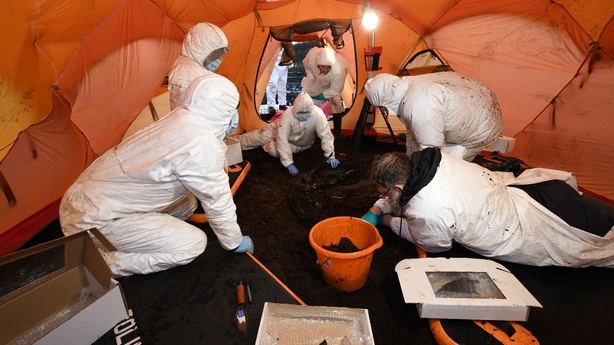Experts say a body found in a bog in Co Derry dates back to 500BC and the Iron Age.
It was found last October by workers at a commercial peat extraction company at Newferry, near Bellaghy.
Police were called in after the remains were found.
They were subsequently taken for carbon dating to establish their age.
A post mortem carried out by a certified forensic anthropologist found that the person was most likely a man, aged between 13-17 years old at the time of death.
Whilst little is known so far about the man's cause of death, unlike some other 'bog bodies’ the person's skeleton was well preserved and also had the presence of partial skin, fingernails of the left hand, toenails and possibly a kidney.
The find was made near where Nobel Laureate Seamus Heaney was born.
He wrote extensively about bog bodies in his poetry.
The site is on the edge of Lough Beg, an extension of Lough Neagh and an internationally important bird sanctuary.

Detective Inspector Nikki Deehan said: "On initial examination, we couldn’t be sure if the remains were ancient or the result of a more recent death.
"Therefore, we proceeded to excavate the body with full forensic considerations in a sensitive and professional manner. This approach also ensures that any DNA evidence could be secured for any potential criminal investigation. Ultimately this wasn’t the case in this instance."
The excavations first uncovered a tibia and fibula and a humerus, ulna, and radius bone relating to the lower left leg and right arm respectively.
Further investigation revealed more bones belonging to the same person. About five metres south of the surface remains, the bones of a lower left arm and a left femur were located protruding from the ground.
Additional finger bones, fingernails, part of the left femur and the breastbone were located between the main body and the surface remains.
Detective Inspector Nikki Deehan continued: "The well-preserved nature of the body meant radiocarbon dating could be used to ascertain the time of death.
"The radiocarbon dates have placed the time of death between 2,000 - 2,500 years ago, approximately 500BC.
"This is the first time radiocarbon dating has been used on a bog body in Northern Ireland, and the only one to still exist, making this a truly unique archaeological discovery for Northern Ireland."
The radiocarbon dating was conducted at the 14Chrono Centre, part of Queen's University Belfast.
Dr Alastair Ruffell of Queen’s University, Belfast said: "To ensure the highest possible standards in forensic recovery of human remains were maintained, we conducted two phases of high-resolution ground penetrating radar survey at the site. The results showed no indications of further human remains.
"The remains were discovered at approximately one metre below the current land surface which matches the radiocarbon estimates. In addition, they were amongst a cluster of fossil tree remains suggesting that the body may have died or been buried in a copse or stand of trees, or washed in."
John Joe O’Boyle, Chief Executive of Forest Service, said: "Forest Service recognises the significance of this very exciting find. This ancient bog body was discovered on land owned by the Department and we are now working with National Museums NI to transfer it to them so that they can continue with further examination and preservation of the remains.
"I hope, in due course, the find will help us all understand better something of our very early history.
"Seamus Heaney, when he was writing his series of poems inspired by bog bodies, probably never expected such a find on his own doorstep. It certainly adds an important chapter to the historical and cultural significance of this hinterland and archaeological discoveries of bog bodies across Europe."
National Museums NI, as the organisation with statutory responsibilities for acquiring and preserving archaeological finds from our past, has been engaged to ensure the proper care of the remains.





